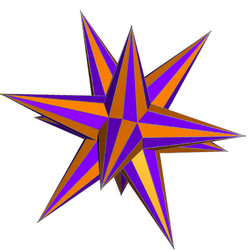Truncated dodecadodecahedron
| Truncated dodecadodecahedron | |
|---|---|

| |
| Type | Uniform star polyhedron |
| Elements | F = 54, E = 180 V = 120 (χ = −6) |
| Faces by sides | 30{4}+12{10}+12{10/3} |
| Wythoff symbol | 2 5 5/3 | |
| Symmetry group | Ih, [5,3], *532 |
| Index references | U59, C75, W98 |
| Dual polyhedron | Medial disdyakis triacontahedron |
| Vertex figure |  4.10/9.10/3 |
| Bowers acronym | Quitdid |
File:Truncated dodecadodecahedron.stl
In geometry, the truncated dodecadodecahedron (or stellatruncated dodecadodecahedron) is a nonconvex uniform polyhedron, indexed as U59. It is given a Schläfli symbol t0,1,2{5⁄3,5}. It has 54 faces (30 squares, 12 decagons, and 12 decagrams), 180 edges, and 120 vertices.[1] The central region of the polyhedron is connected to the exterior via 20 small triangular holes.
The name truncated dodecadodecahedron is somewhat misleading: truncation of the dodecadodecahedron would produce rectangular faces rather than squares, and the pentagram faces of the dodecadodecahedron would turn into truncated pentagrams rather than decagrams. However, it is the quasitruncation of the dodecadodecahedron, as defined by (Coxeter Longuet-Higgins).[2]
Cartesian coordinates
Cartesian coordinates for the vertices of a truncated dodecadodecahedron are all the triples of numbers obtained by circular shifts and sign changes from the following points (where is the golden ratio):
Each of these five points has eight possible sign patterns and three possible circular shifts, giving a total of 120 different points.
As a Cayley graph
The truncated dodecadodecahedron forms a Cayley graph for the symmetric group on five elements, as generated by two group members: one that swaps the first two elements of a five-tuple, and one that performs a circular shift operation on the last four elements. That is, the 120 vertices of the polyhedron may be placed in one-to-one correspondence with the 5! permutations on five elements, in such a way that the three neighbors of each vertex are the three permutations formed from it by swapping the first two elements or circularly shifting (in either direction) the last four elements.[3]
Related polyhedra
Medial disdyakis triacontahedron
| Medial disdyakis triacontahedron | |
|---|---|

| |
| Type | Star polyhedron |
| Face | 
|
| Elements | F = 120, E = 180 V = 54 (χ = −6) |
| Symmetry group | Ih, [5,3], *532 |
| Index references | DU59 |
| dual polyhedron | Truncated dodecadodecahedron |
File:Medial disdyakis triacontahedron.stl The medial disdyakis triacontahedron is a nonconvex isohedral polyhedron. It is the dual of the uniform truncated dodecadodecahedron.
See also
References
- ↑ Maeder, Roman. "59: truncated dodecadodecahedron". https://www.mathconsult.ch/static/unipoly/59.html.
- ↑ Pitsch, Johann (1881), "Über halbreguläre Sternpolyeder", Zeitschrift für das Realschulwesen 6: 9–24, 72–89, 216. According to (Coxeter Longuet-Higgins), the truncated dodecadodecahedron appears as no. XII on p.86.
- ↑ Tollis, Ioannis G.; Patrignani, Marizio, eds. (2009), "The topology of bendless three-dimensional orthogonal graph drawing", Lecture Notes in Computer Science, 5417, Heraklion, Crete: Springer-Verlag, pp. 78–89, doi:10.1007/978-3-642-00219-9_9, ISBN 978-3-642-00218-2.
- Wenninger, Magnus (1983), Dual Models, Cambridge University Press, doi:10.1017/CBO9780511569371, ISBN 978-0-521-54325-5
External links
- Weisstein, Eric W.. "Truncated dodecadodecahedron". http://mathworld.wolfram.com/TruncatedDodecadodecahedron.html.
- Weisstein, Eric W.. "Medial disdyakis triacontahedron". http://mathworld.wolfram.com/MedialDisdyakisTriacontahedron.html.
 |
